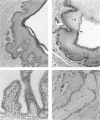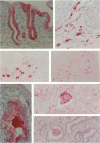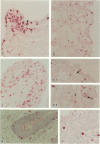Abstract
The human penile urethra contains numerous IgA and J chain-positive plasma cells, and the epithelium expresses secretory component, the transport molecule for polymeric IgA, indicating that this region is an active site of secretory IgA-mediated immune defense. At the distal tip, the mucosae of the meatus and fossa navicularis contain intraepithelial dendritic cells but few macrophages, whereas the urethra proper contains many macrophages within the lamina propria and epithelium, but no dendritic cells. T lymphocytes are abundant and ubiquitous in all regions of the urethra. Both CD8+ and CD4+ subpopulations of T lymphocytes are present in the lamina propria and epithelium, although CD8+ cells predominate. The majority of T lymphocytes are positive for CD45RO (memory marker), and many are also positive for the alpha E beta 7 integrin (mucosal-associated antigen). These data indicate that the human urethra is a highly dynamic immunocompetent tissue possessing all the necessary elements for antigen presentation and both humoral and cellular mucosal immune responses. Furthermore, the urethra resembles other mucosal surfaces in terms of lymphocyte subpopulations, segregation of phenotypes and expression of antigenic determinants characteristic of mucosal lymphocytes. It is likely that this region plays a dominant role in protecting the male urogenital tract against ascending infections, and should be targeted in vaccination strategies directed against sexually transmitted diseases.
Full text
PDF










Images in this article
Selected References
These references are in PubMed. This may not be the complete list of references from this article.
- Brandtzaeg P. Mucosal and glandular distribution of immunoglobulin components. Immunohistochemistry with a cold ethanol-fixation technique. Immunology. 1974 Jun;26(6):1101–1114. [PMC free article] [PubMed] [Google Scholar]
- Cerf-Bensussan N., Jarry A., Brousse N., Lisowska-Grospierre B., Guy-Grand D., Griscelli C. A monoclonal antibody (HML-1) defining a novel membrane molecule present on human intestinal lymphocytes. Eur J Immunol. 1987 Sep;17(9):1279–1285. doi: 10.1002/eji.1830170910. [DOI] [PubMed] [Google Scholar]
- Fowler J. E., Jr, Mariano M. Immunoglobulin in seminal fluid of fertile, infertile, vasectomy and vasectomy reversal patients. J Urol. 1983 Apr;129(4):869–872. doi: 10.1016/s0022-5347(17)52403-9. [DOI] [PubMed] [Google Scholar]
- Friberg J. Immunoglobulin concentration in serum and seminal fluid from men with and without sperm-agglutinating antibodies. Am J Obstet Gynecol. 1980 Mar 1;136(5):671–675. doi: 10.1016/0002-9378(80)91022-4. [DOI] [PubMed] [Google Scholar]
- Husband A. J., Clifton V. L. Role of intestinal immunization in urinary tract defence. Immunol Cell Biol. 1989 Dec;67(Pt 6):371–376. doi: 10.1038/icb.1989.53. [DOI] [PubMed] [Google Scholar]
- Ilaria G., Jacobs J. L., Polsky B., Koll B., Baron P., MacLow C., Armstrong D., Schlegel P. N. Detection of HIV-1 DNA sequences in pre-ejaculatory fluid. Lancet. 1992 Dec 12;340(8833):1469–1469. doi: 10.1016/0140-6736(92)92658-3. [DOI] [PubMed] [Google Scholar]
- Kearns D. H., O'Reilly R. J., Lee L., Welch B. G. Secretory IgA antibodies in the urethral exudate of men with uncomplicated urethritis due to Neisseria gonorrhoeae. J Infect Dis. 1973 Jan;127(1):99–101. doi: 10.1093/infdis/127.1.99. [DOI] [PubMed] [Google Scholar]
- Lehner T., Bergmeier L. A., Tao L., Panagiotidi C., Klavinskis L. S., Hussain L., Ward R. G., Meyers N., Adams S. E., Gearing A. J. Targeted lymph node immunization with simian immunodeficiency virus p27 antigen to elicit genital, rectal, and urinary immune responses in nonhuman primates. J Immunol. 1994 Aug 15;153(4):1858–1868. [PubMed] [Google Scholar]
- McMillan A., McNeillage G., Young H. Antibodies to Neisseria gonorrhoeae: a study of the urethral exudates of 232 men. J Infect Dis. 1979 Jul;140(1):89–95. doi: 10.1093/infdis/140.1.89. [DOI] [PubMed] [Google Scholar]
- Parker C. M., Cepek K. L., Russell G. J., Shaw S. K., Posnett D. N., Schwarting R., Brenner M. B. A family of beta 7 integrins on human mucosal lymphocytes. Proc Natl Acad Sci U S A. 1992 Mar 1;89(5):1924–1928. doi: 10.1073/pnas.89.5.1924. [DOI] [PMC free article] [PubMed] [Google Scholar]
- Parr M. B., Parr E. L. Immunohistochemical localization of secretory component and immunoglobulin A in the urogenital tract of the male rodent. J Reprod Fertil. 1989 Jan;85(1):115–124. doi: 10.1530/jrf.0.0850115. [DOI] [PubMed] [Google Scholar]
- Pudney J., Oneta M., Mayer K., Seage G., 3rd, Anderson D. Pre-ejaculatory fluid as potential vector for sexual transmission of HIV-1. Lancet. 1992 Dec 12;340(8833):1470–1470. doi: 10.1016/0140-6736(92)92659-4. [DOI] [PubMed] [Google Scholar]
- Quayle A. J., Pudney J., Muñoz D. E., Anderson D. J. Characterization of T lymphocytes and antigen-presenting cells in the murine male urethra. Biol Reprod. 1994 Nov;51(5):809–820. doi: 10.1095/biolreprod51.5.809. [DOI] [PubMed] [Google Scholar]
- Ritchie A. W., Hargreave T. B., James K., Chisholm G. D. Intra-epithelial lymphocytes in the normal epididymis. A mechanism for tolerance to sperm auto-antigens? Br J Urol. 1984 Feb;56(1):79–83. doi: 10.1111/j.1464-410x.1984.tb07169.x. [DOI] [PubMed] [Google Scholar]
- Russell G. J., Nagler-Anderson C., Anderson P., Bhan A. K. Cytotoxic potential of intraepithelial lymphocytes (IELs). Presence of TIA-1, the cytolytic granule-associated protein, in human IELs in normal and diseased intestine. Am J Pathol. 1993 Aug;143(2):350–354. [PMC free article] [PubMed] [Google Scholar]
- Rümke P. The origin of immunoglobulins in semen. Clin Exp Immunol. 1974 Jun;17(2):287–297. [PMC free article] [PubMed] [Google Scholar]
- Svanborg-Edén C., Svennerholm A. M. Secretory immunoglobulin A and G antibodies prevent adhesion of Escherichia coli to human urinary tract epithelial cells. Infect Immun. 1978 Dec;22(3):790–797. doi: 10.1128/iai.22.3.790-797.1978. [DOI] [PMC free article] [PubMed] [Google Scholar]
- Tauber P. F., Zaneveld L. J., Propping D., Schumacher G. F. Components of human split ejaculates. I. Spermatozoa, fructose, immunoglobulins, albumin, lactoferrin, transferrin and other plasma proteins. J Reprod Fertil. 1975 May;43(2):249–267. doi: 10.1530/jrf.0.0430249. [DOI] [PubMed] [Google Scholar]
- Taylor H. P., Dimmock N. J. Mechanism of neutralization of influenza virus by secretory IgA is different from that of monomeric IgA or IgG. J Exp Med. 1985 Jan 1;161(1):198–209. doi: 10.1084/jem.161.1.198. [DOI] [PMC free article] [PubMed] [Google Scholar]
- Tjokronegoro A., Sirisinha S. Quantitative analysis of immunoglobulins and albumin in secretion of female reproductive tract. Fertil Steril. 1975 May;26(5):413–417. doi: 10.1016/s0015-0282(16)41112-x. [DOI] [PubMed] [Google Scholar]
- Uehling D. T. Secretory IgA in seminal fluid. Fertil Steril. 1971 Nov;22(11):769–773. [PubMed] [Google Scholar]
- Williams R. C., Gibbons R. J. Inhibition of bacterial adherence by secretory immunoglobulin A: a mechanism of antigen disposal. Science. 1972 Aug 25;177(4050):697–699. doi: 10.1126/science.177.4050.697. [DOI] [PubMed] [Google Scholar]






